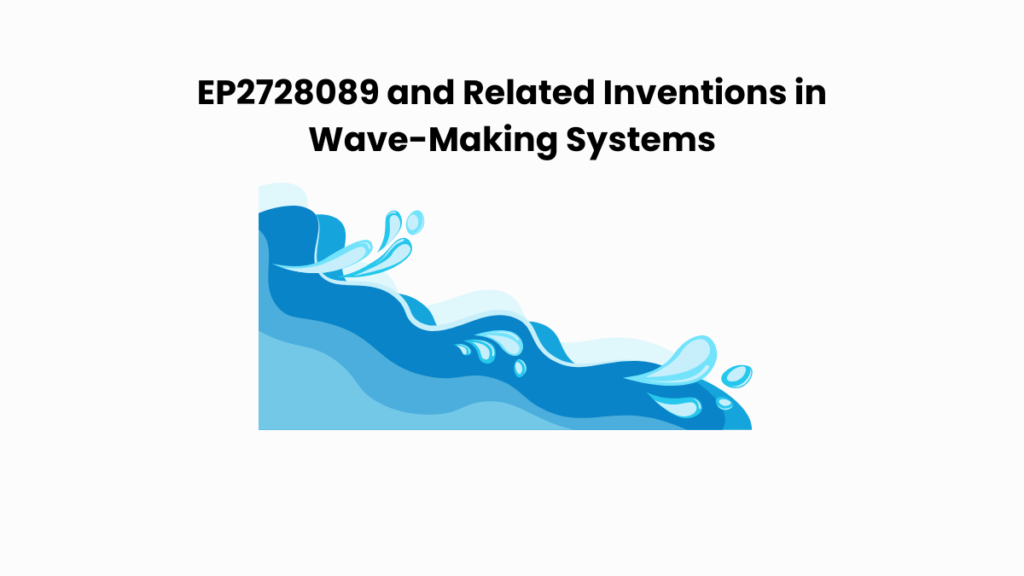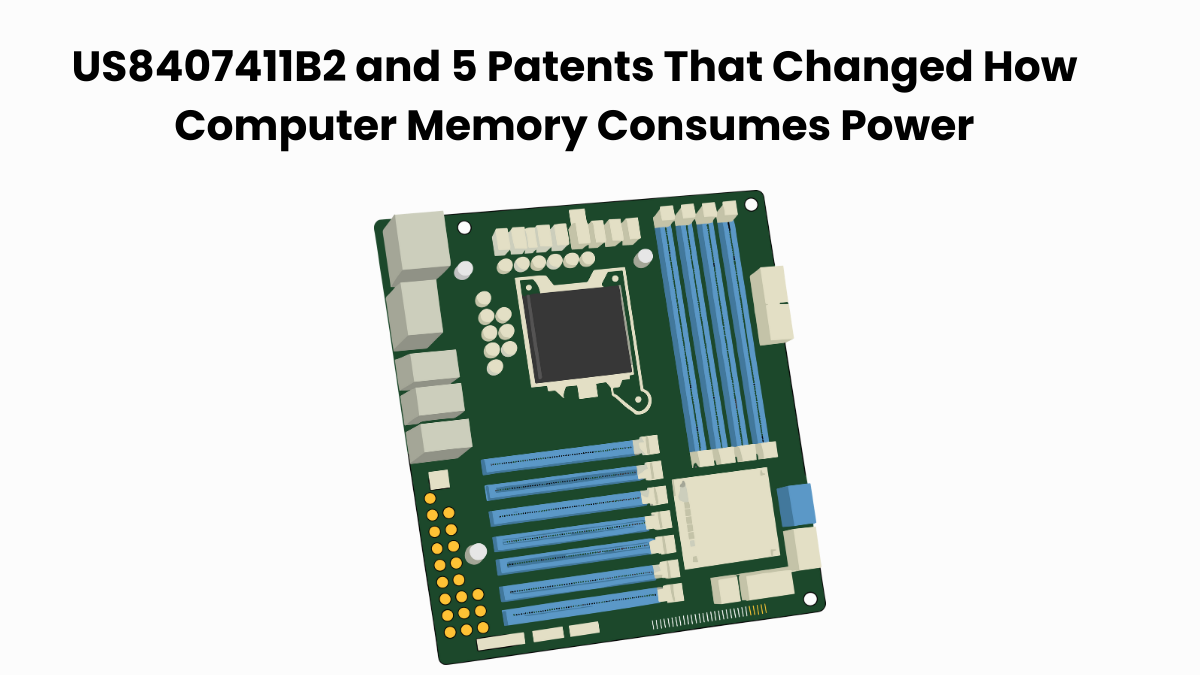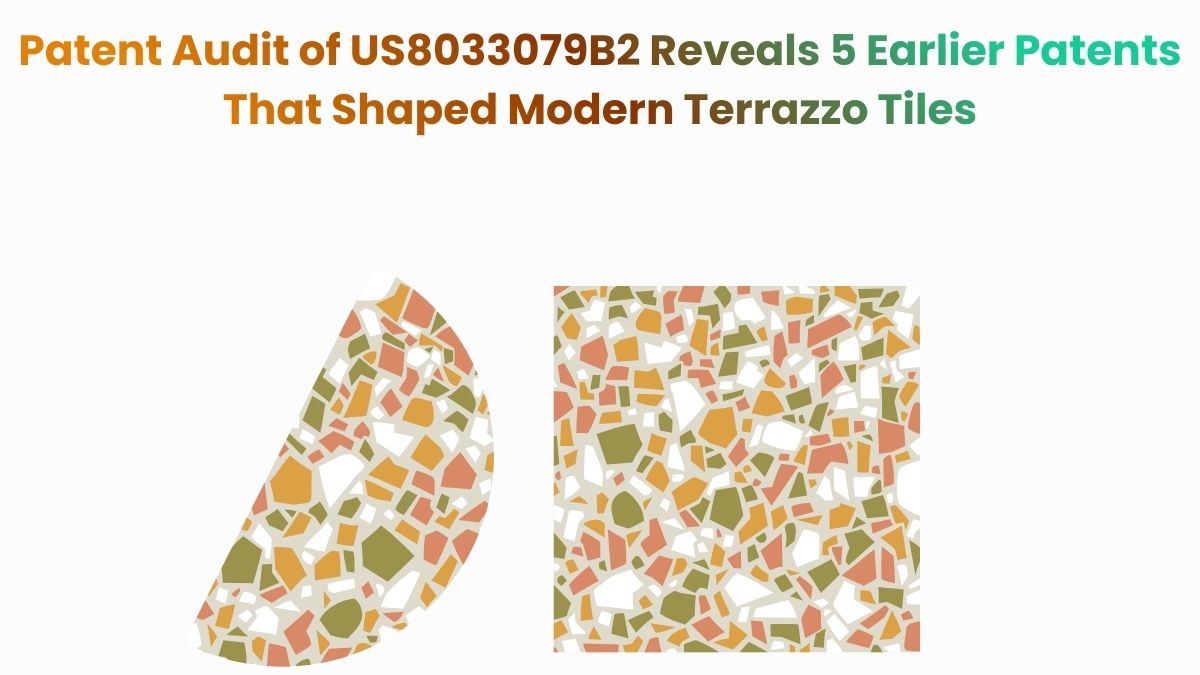Some inventions make a brief appearance and fade. Others leave a lasting mark by redefining how a technology is experienced.
EP2728089B1, owned by American Wave Machines, falls firmly into that second category. It is now challenged in a counterclaim for revocation by Surftown GmbH.
This European patent covers a sequenced chamber wave generator with a connected controller that shapes rideable waves in size, form, and rhythm. Users can design and share wave profiles, creating repeatable experiences for riders or fresh challenges to master.
In this article, we use the Global Patent Search (GPS) tool to uncover patents with comparable features or engineering concepts. Our aim is not to discuss court strategies, but to map the technology landscape surrounding EP2728089B1. If you follow innovation in aquatic sports, this exploration offers a clear, data-backed view of related inventions.
Understanding Patent EP2728089B1
EP2728089B1 describes a sequenced chamber wave generator controller and method. The system is designed for aquatic sports and amusement, producing customizable rideable waves through precisely timed chamber actuation. It integrates a pool, multiple water-releasing chambers, and a mobile application controller that can operate locally or remotely via network connection.
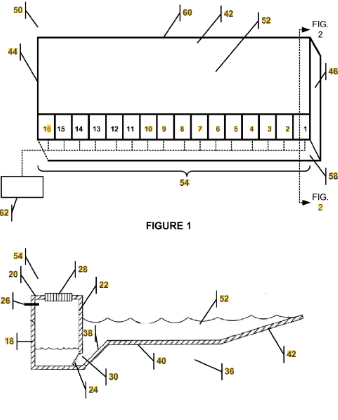
Source: Google Patents
Its Four Key Features Are
#1. Sequenced chamber actuation – Multiple wave-generating chambers operate in a timed sequence with adjustable delays to produce varied wave shapes, sizes, and travel directions.
#2. Mobile application control – A connected controller with a graphical user interface enables users to create, modify, and schedule wave profiles.
#3. Customizable and shareable wave profiles – Users can design unique wave patterns, save them, and share them with others for replication or competition.
#4. Remote and network-enabled operation – The wave generator can be controlled over the internet, wireless networks, or VPN, allowing off-site wave creation.
This technology enables precise, on-demand wave customization for recreational, training, and competitive surfing. It forms a flexible platform for next-generation artificial wave generation systems.
Note: Water movement and airflow share sequencing logic. The patents in this article show timed chambers shaping predictable waves. This is similar to EP3119235B1, which channels airflow for repeatable styling effects.
Similar Patents As EP2728089B1
To explore the innovation landscape surrounding EP2728089B1, we ran the patent through the Global Patent Search tool. Below is a quick glimpse of the GPS tool in action:
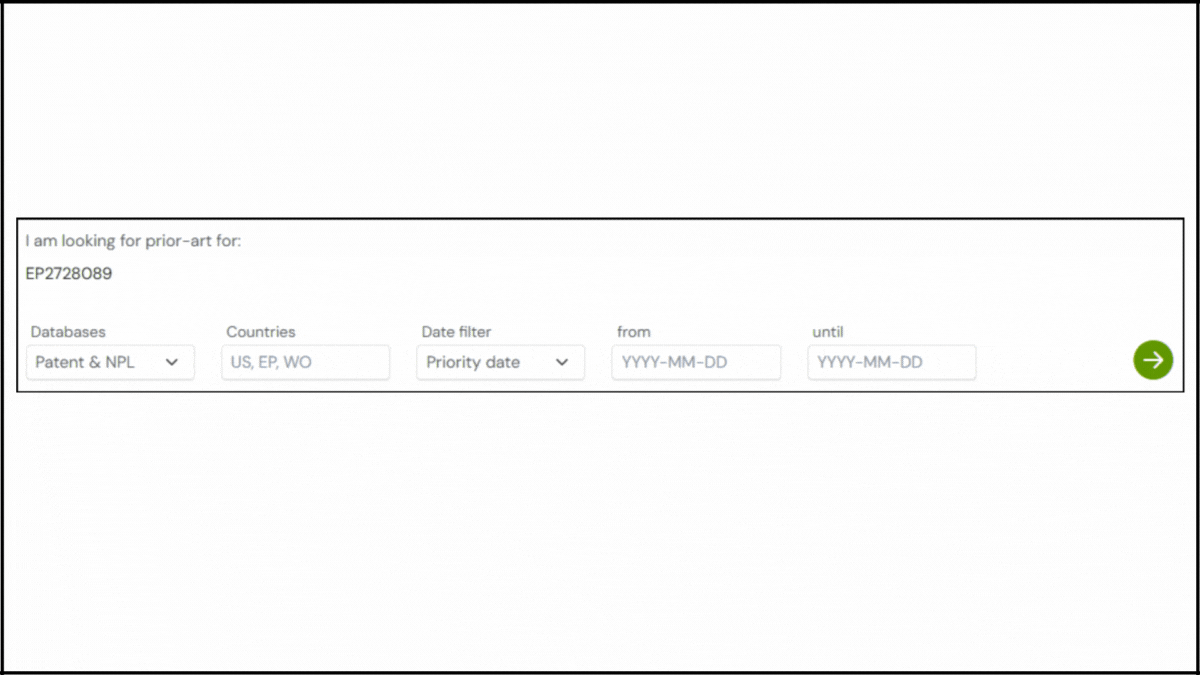
Source: Global Patent Search
This analysis surfaced a range of related patents that share technical concepts in artificial wave generation, control systems, and customizable wave patterns.
Below, we highlight five references that demonstrate comparable approaches to shaping water movement for recreational purposes.
#1. JPH0412779A
This Japanese patent JPH0412779A, published in 1992, describes a wave pool system using multiple “jet style” generating parts arranged in a matrix at the pool bottom. Operated alternately by a control mechanism, the jets create both linear and zigzag-shaped waves. The system also allows for easy conversion between a standard pool and a wave pool by adding or removing the jet units.
Below, we have added snapshots from the GPS tool highlighting the relevant snippets from the specification for the similar patents.
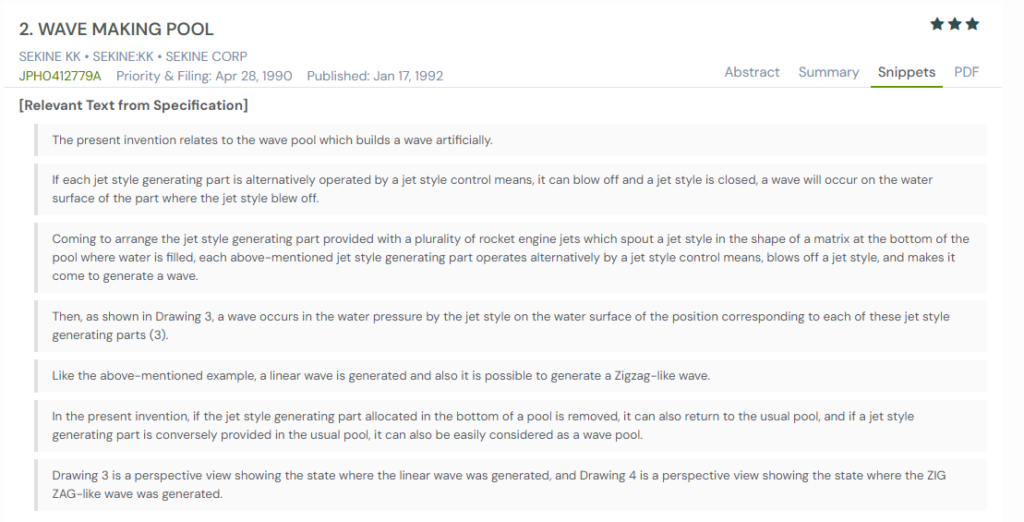
What This Patent Introduces To The Landscape
- Multiple jet units positioned at the pool bottom for targeted wave creation.
- Sequential activation and deactivation of jets to produce varying waveforms.
- Capability to produce both straight-line and zigzag-shaped waves.
- Removable jet units allow the pool to revert to standard use or be converted into a wave pool.
How It Connects To EP2728089B1
- Both use multiple water-moving units arranged for precise wave pattern creation.
- Both employ sequencing or alternating control to vary waveforms.
- Both aim to provide versatile recreational wave environments with customizable experiences.
Why This Matters
This earlier design demonstrates alternative mechanical approaches to customizable wave creation, reinforcing the diversity of engineering strategies that aim to enhance recreational wave experiences.
Did you know? Sequenced chamber actuation in EP2728089B1 and similar patents mirrors EP4249647A1’s controlled fluid flow. Both convert complex forces into predictable, repeatable outcomes.
#2. RU2592935C2
This Russian patent RU2592935C2, published in 2016, describes a wave pool design with a centrally located wave-generating mechanism capable of producing waves that radiate outward in multiple directions, up to 360 degrees, towards the perimeter of the pool. The system can create varied wave types and patterns, including spiral formations, to offer different recreational experiences within the same facility.
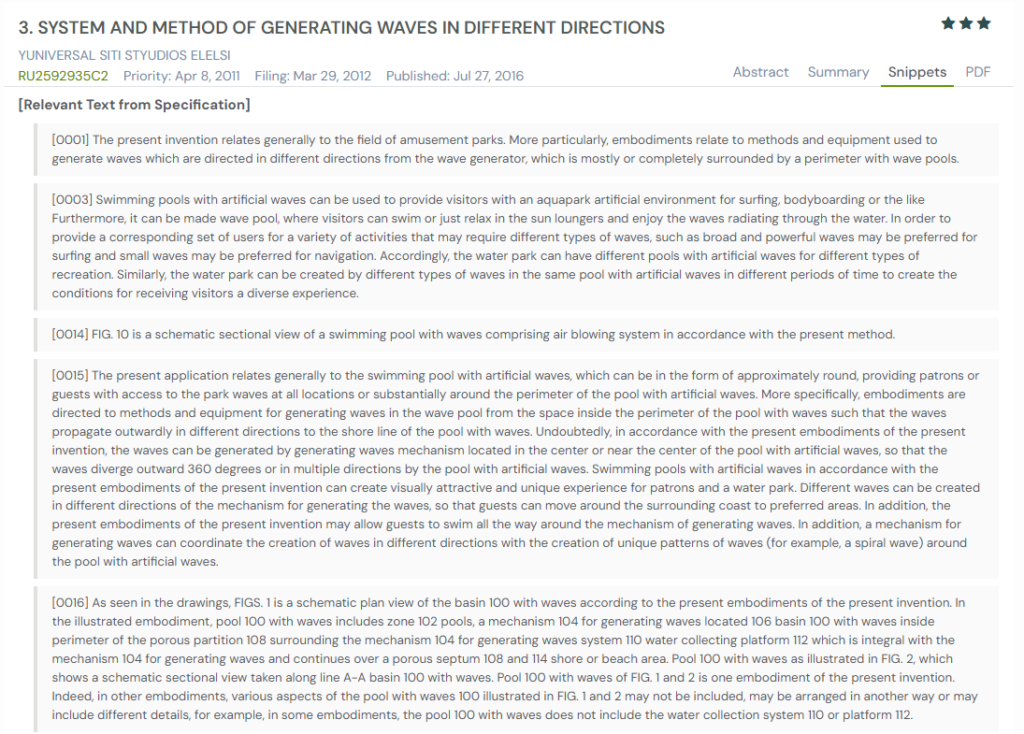
What This Patent Introduces To The Landscape
- Centrally positioned wave generation mechanism that produces outward-propagating waves in multiple or all directions.
- Polygonal or circular wave generator configurations to shape and control wave distribution.
- Multiple wave creation methods, including plungers, water discharge systems, and compressed air systems.
- Capability to generate patterned waves, such as spirals, for visual and recreational variety.
- Integrated water collection and recirculation systems to enhance wave efficiency and reduce interference.
- Variable slope and shoreline configurations to modify wave breaking characteristics in different pool zones.
How It Connects To EP2728089B1
- Both focus on controlled, repeatable wave generation for recreational and competitive environments.
- Both use sequencing or coordinated actuation of multiple components to produce varied wave patterns.
- Both aim to provide diverse wave experiences through adjustable operating parameters and system configurations.
Why This Matters
This invention illustrates an alternative centralized approach to multi-directional wave creation, expanding the range of engineering solutions available for delivering customizable wave experiences in aquatic facilities.
Related Read: To know more about the hose assembly designed to regulate water pressure, read our blog on Expandable Hose patents.
#3. EP0060874A1
This European patent EP0060874A1, published in 1982, describes a wave-generating device that uses air chambers with variable air cushions to pump water in and out of a pool. The design eliminates the need for moving mechanical parts inside the pool itself, reducing maintenance challenges and safety hazards while enabling continuous wave production with adjustable characteristics.
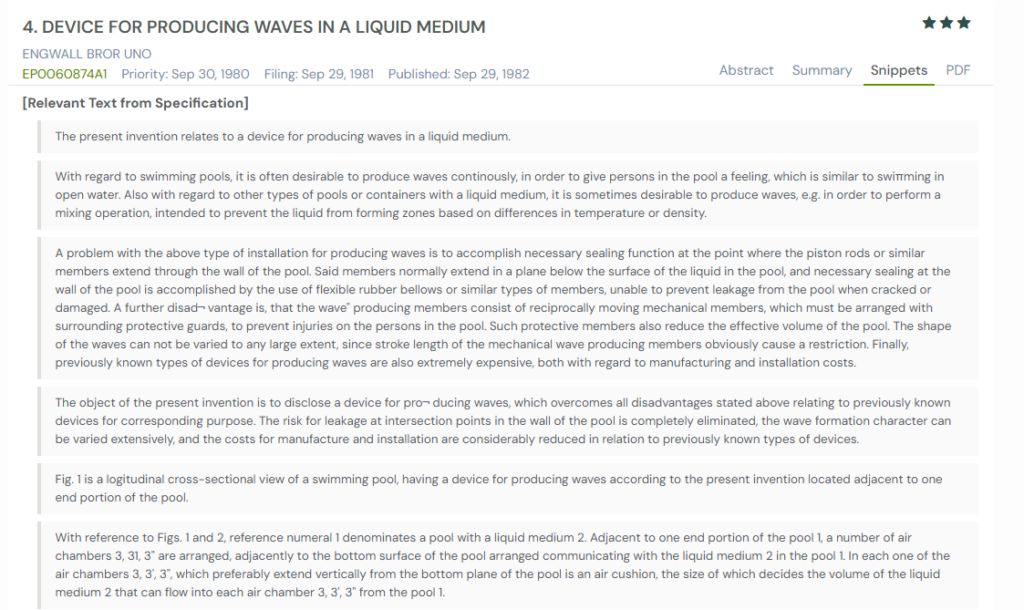
What This Patent Introduces To The Landscape
- Air chamber-based wave generation using variable air cushion volumes.
- Elimination of moving mechanical members in contact with pool water for improved safety and reduced maintenance.
- Continuous and alternating pumping action to sustain wave formation.
- Adjustable wave characteristics via changes to motor speed and stroke length.
- Ability to drive air chamber pumps at different paces to produce varied wave patterns.
- Accessible component placement allowing service without draining the pool.
How It Connects To EP2728089B1
- Both aim to produce controlled, varied wave characteristics for aquatic environments.
- Both use a system of multiple chambers to sequence and shape wave patterns.
- Both focus on operational flexibility to create different wave experiences.
Why This Matters
This invention demonstrates an early, mechanically simplified approach to customizable wave generation, aligning with the broader trend toward adaptable, safe, and efficient wave-making systems in recreational settings.
If you want to see how leading companies are applying patent-driven innovation in real consumer products, our report on the Top 55 Companies Driving Innovation in Coffee Making Machines is a great example of how patents translate into real-world engineering breakthroughs.
#4. BR112013028436B1
This Brazilian patent, BR112013028436B1, published in 2020, describes a wave pool system using a sequence of staggered wave generators with extended parallel dividing walls. The arrangement enables multiple wave segments to form and converge into a single progressive wave that breaks at an oblique angle along an inclined bank, producing high-quality surfable waves with minimal turbulence.

What This Patent Introduces To The Landscape
- Staggered arrangement of multiple wave generators to form sequential wave segments.
- Extended parallel dividing walls in front of each wave generator to confine wave energy and preserve size and shape.
- Sequential activation of generators to synchronize wave segment convergence.
- Formation of progressive waves breaking laterally along an inclined surf bank.
- Reduction of turbulence and energy loss by controlling convergence zones.
- Capability to adjust timing and frequency for consistent wave quality.
- Integration of various wave generation types, including pneumatic, hydraulic, and mechanical systems.
How It Connects To EP2728089B1
- Both rely on sequenced activation of multiple generators or chambers to create controlled, continuous waves.
- Both focus on maintaining wave quality and consistency through precise timing and energy management.
- Both aim to deliver repeatable, high-performance waves for surfing and aquatic sports.
Why This Matters
This invention refines the concept of segmented, sequenced wave generation to produce competition-grade surf waves, highlighting engineering strategies for achieving stability and performance in artificial wave environments.
Related Read: Artificial wave generators must survive repeated, high-force impacts from moving water. Mailbox reinforcement patents address the same engineering problem on a smaller scale, strengthening structures against continuous physical stress.
#5. US4999860A
This US patent US4999860A, published in 1991, describes a wave generation system using multiple chambers, each capable of producing two distinct types of waves – smaller, rhythmic recreational waves via pneumatic means, and large surf-simulating waves via water release from elevated reservoirs. The design allows for various wavefront shapes and sequences, enhancing both entertainment and surf training applications.
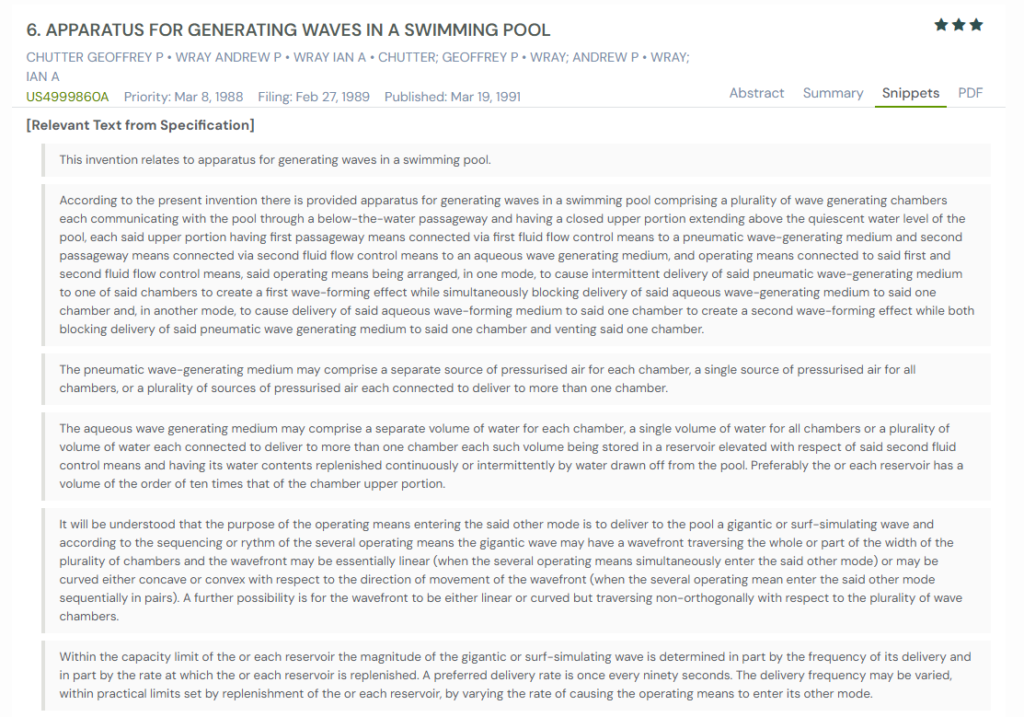
What This Patent Introduces To The Landscape
- Dual-mode wave generation: pneumatic for smaller waves and aqueous for large surf-like waves.
- Multiple chambers with independent or coordinated operation for varied wave patterns.
- Elevated water reservoirs with high-volume release for powerful wave creation.
- Sequenced activation to form linear, concave, convex, or angled wavefronts.
- Curved guide surfaces and reef-like floor protrusions to improve wave quality and reduce turbulence.
- Adjustable delivery frequency to control wave magnitude and timing.
How It Connects To EP2728089B1
- Both employ multiple chambers for controlled, repeatable wave generation.
- Both allow adjustment of wave type, size, and sequencing for varied aquatic experiences.
- Both integrate design features to minimize turbulence and enhance wave quality.
Why This Matters
This invention showcases a flexible, multi-mode approach to artificial wave creation, bridging casual recreational use and performance surfing, while emphasizing control over wave shape, timing, and energy delivery.
Recommended Read: Learn how sensor-driven monitoring and adaptive control are reshaping smart pool and spa systems.
How to Find Related Patents Using Global Patent Search

Understanding the broader patent landscape is key when exploring wave pool engineering, artificial surf creation, or water-based amusement systems. The Global Patent Search tool streamlines this process, helping users identify designs that share similar hydrodynamic concepts, wave sequencing strategies, or energy-efficient water displacement methods.
1. Enter the patent number into GPS: Start by entering a patent number like EP2728089B1 into the GPS tool. The platform transforms it into a smart query, which you can refine using terms like “wave sequencing,” “water displacement,” or “surfable wave formation.”

2. Explore conceptual snippets: Instead of comparing features claim-by-claim, GPS now offers curated text snippets. These highlight how other systems manage wave energy, control timing, or shape water flow to create varied aquatic experiences.
3. Identify related inventions: The tool reveals patents that tackle progressive wave formation, multi-directional wave generation, or stability improvements in artificial surf systems, showing how related engineering challenges have been approached over time.
4. Compare systems, not legal claims: Rather than focusing on formal legal language, GPS compares functional designs. This helps users trace hydrodynamic overlaps without navigating legal claim boundaries.
5. Accelerate cross-domain insights: Whether you’re working in aquatic entertainment, sports training facilities, or coastal engineering, GPS lets you uncover related ideas across technical domains that might otherwise be hard to connect.
Our guide to the best AI-powered patent search tools shows how GPS compares with other platforms.
With this approach, Global Patent Search gives designers, engineers, and IP analysts a structured, concept-first way to explore related technologies and shape more innovative wave-making solutions.
Disclaimer: The information provided in this article is for informational purposes only and should not be considered legal advice. The related patent references mentioned are preliminary results from the Global Patent Search tool and do not guarantee legal significance. For a comprehensive related patent analysis, we recommend conducting a detailed search using GPS or consulting a patent attorney.

